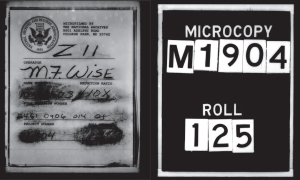Following my last post I remembered I had a book about African Americans in Kentucky named A History of Blacks in Kentucky – From Slavery to Segregation, 1760-1891, written by Marion B. Lucas. And yes, that is where I had read the story about the school teacher Reverend Abisha Scofield, of the American Missionary Association, and John Burnside¹. The violence against blacks, particularly black soldiers and their families, is described in detail and left me thinking about what some of my family must have gone through, since I have confirmation that my 3xgrandfather and his brother, Edmund and William Overstreet respectively, both fought in the Civil War and enlisted at Camp Nelson.

This is the next letter pertaining to the incident in the Freedmen’s Bureau Records, written 2 December, 1866 and signed by J.G. Nain:
Sir
I have the honor to request that you send to Camp Nelson a detachment of troops to remain there for ten days, until Mr. Schofield can get his busines setled up. He has a great deal of business there in an unfinished condition, business pertaining to the claims of colored soldiers there widows [?] pay bounty, pensions [?], and he dare not remain there without the protection of the military. I would suggest that he be protected there until he can get his business straitened out and then withdraw the books, ordering him to leave. I think it would be much better for the freed men there to have him go, as he inspires them in a great many ways.
I have not seen Susan Luther to obtain any additional evidence in the Hick and Grant case.
I have learned where she is, and have sent for her. As soon as she reports, I will send you all the information I can get from her.
I think it should be immediately sent to Lou-ville, as the friends of the prisoners are there trying to get them released on bonds.
After the troops left Camp Nelson the harassment went on. So much so that the black preacher Gabriel Burdett had to aid the missionaries in escaping to safety.²
Last year I became a member of the Jessamine County Historical Society. I sent a look-up request to them a few weeks ago and received a letter stating that the marriage license of my ancestors Edmund Overtsreet and Josie Washington was special, because they had been married by Gabriel Burdett! Gabriel Burdett helped John G. Fee establish Ariel Academy, one of the early black schools in the county.
This proves to me that I have strong ties to Camp Nelson and makes me even more eager to keep digging into the Freedmen’s Bureau Records and anything else I can get my hands on from this locality. It’s a good thing I ordered that book about Camp Nelson….

I would still like to see if there is a connection to the man left for dead after the violent icident at Camp Nelson: John Burnside. I do know that one of Edmund’s sisters married a James Burnside. Fortunately, I have a copy of a family reunion booklet containing the marriages of Ed and his siblings. Further investigation is needed on that lead. So much to do, so little time!
¹ Lucas, Marion B. , (2003). A History of Blacks in Kentucky: From Slavery to Segregation, 1760-1891. 2nd ed. U.S.A.: Kentucky Historical Society. p.193
² dto., p.194

